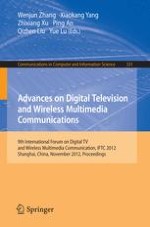2012 | Book
Advances on Digital Television and Wireless Multimedia Communications
9th International Forum on Digital TV and Wireless Multimedia Communication, IFTC 2012, Shanghai, China, November 9-10, 2012. Proceedings
Editors: Wenjun Zhang, Xiaokang Yang, Zhixiang Xu, Ping An, Qizhen Liu, Yue Lu
Publisher: Springer Berlin Heidelberg
Book Series : Communications in Computer and Information Science
